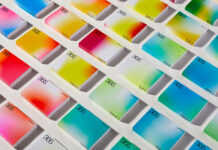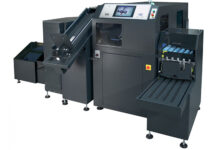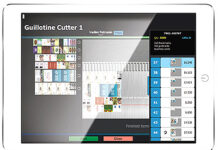by: Dianna Brodine
A complex printed project begins with consultations between customer, printer and binder. The possibilities are discussed, printing and folding options are weighed, and a plan to reach the desired outcome is developed. Once the printed material reaches the bindery, an inaccurate or ragged cut can compromise days or even weeks of work and material. Since paper cutting is a repetitive process that can be automated with little to no operator assistance in most cases, new technology developments in the machinery used for cutting are catching the eye of bindery employees. A reduction in the number of times human hands intervene in a project can lead to a reduction in errors.
Before the First Cut
Before a machine can effectively cut the printed material, the material must first be loaded neatly into the machine. Colter & Peterson has recently installed its second BASA automatic jogging system from Baumann in the United States at a Florida commercial print shop. The BASA is the world’s first totally automatic jogging system that works without operator intervention. Skids of sheets are placed directly from the printing press into the system. They are then automatically counted and jogged. The air is squeezed out of the reams, which are then stored on racks or brought directly into the back of the paper cutter for cutting.
Automated Cutting Technology
Advances in automation can reduce the number of operators needed to finish a project, thereby reducing personnel expenses. To meet the automated cutting needs of binderies, Standard Finishing Systems offers the Standard Horizon HT-30, a three-side trimmer featuring automated job set-ups and quick changeovers to meet the requirements of the short run print-on-demand book market. The HT-30 operates off-line to trim perfect bound books at speeds up to 200 cycles per hour with the ability to store up to 40 different book jobs in memory. A touch screen operator console allows all set-ups to be performed with full automation. Precision stepper motors accurately position all guides and clamps to insure professional quality paper cutting. Up to 12″ of books can be loaded into the in-feed hopper, where books are automatically fed for unattended operation.
Heidelberg USA’s POLAR Automated Cutting for Efficiency System (PACE) is the industry’s first fully automated cutting system from POLAR. By automating the loading, jogging, buffering, cutting, gripping, transporting, and unloading processes, PACE produces high-quality finished products with the least amount of human intervention. PACE increases productivity, lowers costs, and reduces waste. As an added advantage, separate elements of PACE’s technology can be employed to streamline other production runs and requirements.
In addition, WinAmerica, Inc. has introduced the new Pro-Cut 360 36 and 450 45 models. Both models are mechanical knife driven and carry features like double linear back gauges, touch screen Microsoft programmable-based computers, main air table, air side tables, Mitsubishi servo drive, chrome table surface, and heavy duty cast frames.
Small Scale Solutions
There are automated solutions for jobs on a smaller scale, too. The Challenge Machinery Company’s new Spartan 185AEP is a fully programmable 18.5″ table-top paper cutter featuring electric powered knife drive, clamping, and back gauge control. Its software offers the table-top cutter industry its first menu driven controller, enabling the operator to simply navigate the programming sequence. During a program, the 3″ LCD control screen displays the next five cuts, allowing the operator to see where they are in a job at all times. Its memory of 20 programs / 20 cuts per program and exclusive maintenance-free feature makes the Spartan 185AEP a good value in the 18.5″ cutter market.
Rollem International has released the new JETSTREAM, a cutting and collation system ideal for finishing game cards, business cards, and playing cards on smaller formats. The two-directional slitting/perforating system is designed as an economical method for finishing multiple-up products when automated collation is not required. The model includes a manual collating table. Products are processed in one machine, eliminating labor expenses.
Focus on Safety
The Baumcut 31.5 programmable cutter offers high-productivity precision cutting with maximum safety in mind. Infrared safety beams, two-hand timed cut release, and covered rear table help ensure operator safety. The heavy-duty, fully hydraulic cutter features push-button programming and stores up to 99 programs with 6,464 cut steps. Programming is automatic. Simply cut the first ream manually and the cuts are then stored as a program. A large central LCD display indicates data in the selected language. Knife changes are easy, with a front adjustment. Built-in table light and optical cutting line indicator yields more precise cutting.
Unique Solutions
Folded materials scheduled for cutting can bring their own challenges. When planning to run a job two or three up on a folding machine, the folder operator is traditionally limited to slitting only lighter stocks with a limited number of folds. Typical complaints when slitting with conventional tools include ragged edges and crooked cuts. Technifold’s new Multi Tool eliminates these common cutting problems and delivers the capability to get guillotine quality trimming in-line on the folding machine. Using hardened counter knives with a special bevel design, it is now possible to slit or double-trim multiple panel jobs on heavy cover stocks (from 1/8″ trim up to 1 1/8″ trim). The Multi Tool also has a Micro Perforating component available and is made to fit popular MBO, Stahl, Horizon, G&K (Vijuk), and MB folding machines.
For soft cover projects, Zechini has introduced the Zinko, with a unique design that permits a precise trim on the face of gate folded perfect bound, saddle stitched, and sewn books. The Zinko is capable of running at speeds up to 3,000 books/hour in-line with a three knife trimmer or off line.
Start Off Sharp
Of course, for paper cutting machines to work effectively and create crisp, clean edges, the knife blades have to be sharp. GrindTech EdgeSM Technology from Jorson & Carlson is a proven sharpening process in the grinding of knives that has become an effective way of achieving optimum sharpness. The sharpening and honing process is the most important procedure in obtaining sharpness, less dust, better quality of cuts, longer up time, and less change outs. The GrindTech EdgeSM Technology incorporates a custom mechanical sharpening, deburring, and lap grinding process.
With new advances in cutting and trimming technology, binders can insure greater accuracy, reduce the number of operators needed to oversee a job, improve safety levels for their employees, and increase the speed of job throughput for customers. New technology creates a win/win situation for all those involved.




